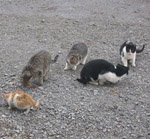The failures of a weed eradication program: lessons learned
 Invasive,
Invasive,  Plants,
Plants,  Restoration
Restoration The idea of eradicating a weed - i.e. killing every individual versus just controlling the spread - has an obvious appeal to a land manager. However, as Mark Gardener and fellow researchers found from a case study in the Galapagos Islands, eradication is very difficult and finding success requires that numerous ecological, financial, and social factors all line up.
The researchers from the Charles Darwin Foundation evaluated a massive 6-year $43 million restoration effort on the islands. The program included 30 invasive weed eradication projects. Invasive species are considered the biggest threat to the biodiversity of the Galapagos - currently 888 introduced plants have established there.
However, many invasive species to the island are fairly new and restricted to inhabited areas which means eradication should be easier than other settings. The program selected target species that were considered potentially invasive but limited enough in distribution that eradication seemed possible.
The study found that after 6 years, only 4 of the 30 projects were successful in completely eradicating their target population. These were species that had not developed a persistent seed bank, had small distributions, and were located entirely on land with a single owner.
Ultimately 64.3% of the program funding was spent on discontinued projects. In trying to understand why such a large percentage of the projects failed, the researchers identified 3 main themes:
1) Lack of permission for eradication - Numerous landowners refused to give permission for eradication on their property. Other than seeking permission, the program for the most part did not engage landowners.
2) Lack of project continuity - Many projects could not be completed within the 6 year funding duration.
3) Species with wider distribution than anticipated - For some selected species, eradication was not implemented because the distribution could not be determined or was shown through mapping to be greater than initially thought.
Lesons learned for future restoration efforts...
While the results of the Galapagos program are disappointing, they are also highly informative for future invasive control efforts on the islands and elsewhere. Below I highlight some of the author recommendations and other lessons learned from the case study:
1) Define total distribution of the target species before anything. Also, review all information on biology and management of target species.
2) Eradication is likely only to be viable when species have small distributions. When species cover large areas, other restoration strategies are likely to be more appropriate.
3) Engaging the community about the importance of the program objectives and including them in decision-making will likely increase acceptance and permission to control target weeds.
4) Continuity of funding is critical. The Galapagos program has taken the step of establishing a $15 million trust fund to provide ongoing funding.
5) Eradication should be considered as one of a number of restoration tools. When eradication is not viable, we may want to focus on preventing further spread. In some cases we may want to accept novel or hybrid ecosystems that contain a mix of native and non-native species and focus our efforts on conserving ecosystem functions.
--Reviewed by Rob Goldstein
Gardener, M., Atkinson, R., & RenterÃa, J. (2009). Eradications and People: Lessons from the Plant Eradication Program in Galapagos Restoration Ecology DOI: 10.1111/j.1526-100X.2009.00614.x




Reader Comments